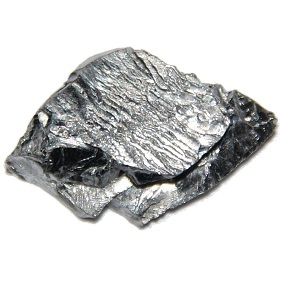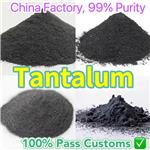Chemical Properties
Tantalum is a blue-gray, ductile metal. It is highly resistant to corrosion though corrosion resistance to strong acids and atmospheric oxygen decreases at increasing temperatures. It is incompatible with strong oxidizers and alkalis.

History
Tantalum was discovered by the Swedish chemist Anders Ekeberg in 1802, although for a long time after his discovery many chemists believed tantalum and niobium were the same element. In 1866, Marignac developed a fractional crystallization method for separation of tantalum from niobium. Ekeberg named the element in honor of Tantalus, who was Niobe’s father in Greek mythology.
Tantalum is never found in nature in free elemental form. The most important mineral is columbite-tantalite (Fe,Mn) (Nb,Ta)2O6. Tantalum also is found in minor quantities in minerals pyrochlore, samarskite, euexenite, and fergusonite. The abundance of tantalum in the earth’s crust is estimated as 2 mg/kg.
Tantalum and its alloys have high melting points, high strength and ductility and show excellent resistance to chemical attack. Tantalum carbide graphite composite is one of the hardest substances ever made and has a melting point over 6,700°C. The pure metal is ductile and can be drawn into fine wire, which is used as filament for evaporating aluminum and other metals.
Uses
Tantalum filaments were used in incandescent lamp bulbs before tungsten replaced them. At temperatures below 150°C, tantalum is attacked only by hydrofluoric acid, fluoride ion in acidic solutions, and free sulfur trioxide. It also is attacked, but slowly, by alkalies. Tantalum and its alloys, therefore, are used to build reactors, vessels, and cruicibles for preparing and carrying out reactions involving many reactive intermediates. The metal and its alloys are used to construct furnace parts, electrolytic capacitors, aircraft and missile parts, chemical process equipment, and nuclear reactors. Being nonreactive to body fluids and a nonirritant to body tissues, tantalum is used in making surgical appliances. Plate and sheet tantalum are applied in bone repair, foil and wire for nerve repair, and plate, gauge, and sheet for repair of abdominal muscle. Tantalum oxide is used to produce optical glasses of high refractive index. The oxide film on the metal makes it a rectifier for converting alternating current to direct current.
Reactions
The most common oxidation state of tantalum is +5 and its aqueous solution chemistry is that of its pentavalent ion Ta5+. Ta metal forms a pentavalent oxide, tantalum pentoxide, Ta2O5, on heating with oxygen. However, at ordinary temperatures a thin layer of oxide covering the metal surface protects tantalum from most chemical attacks. The metal is attacked by hydrofluoric acid below 150°C. It also is dissolved by hot fuming sulfuric acid. It reacts with fluorine and chlorine on heating, forming tantalum pentafluoride, TaF5, and pentachloride, TaCl5, respectively. The metal is immune to dilute aqueous alkalies but is attacked slowly by concentrated fused alkalies. It combines with molecular hydrogen above 250°C. The hydride formed decomposes on heating above 800°C in vacuum. Tantalum forms alloys with several metals.
Chemical Properties
Tantalum is a refractory metal in Group V-B of the periodic table. The pure metal is ductile, steel-blue to gray solid or black, odorless powder.
Physical properties
Tantalum has properties similar to niobium and vanadium above it in group 5. It is a veryhard and heavy metal with a bluish color when in its rough state, but if polished, it has a silveryshine. It is ductile, meaning it can be drawn into fine wires, and also malleable, meaningit can be hammered and worked into shapes. Thin strips and wires of tantalum will ignite inair if exposed to a flame.
Tantalum’s melting point is 2,996°C, which is almost as high as tungsten and rhenium. Itboiling point is 5,425°C, and its density is 19.3 g/cm
3.
Isotopes
There are 49 isotopes of tantalum. Only the isotope Ta-181 is stable andaccounts for 99.988% of the total mass of the element on Earth. Just 0.012% of the element’s mass is contributed by Ta-180, which has a half-life of 1.2×10
+15 years and isthus considered naturally stable. The remaining 47 isotopes are all artificially producedin nuclear reactions or particle accelerators and have half-lives ranging from a few microsecondsto few days to about two years.
Origin of Name
Tantalum was named after Tantalus, who was the father of Niobe, the
queen of Thebes, a city in Greek mythology. (Note: The element tantalum was originally
confused with the element nobelium.)
Occurrence
Tantalum is the 51st most abundant element found on Earth. Although it is found in afree state, it is usually mixed with other minerals and is obtained by heating tantalum potassiumfluoride or by the electrolysis of melted salts of tantalum. Tantalum is mainly obtainedfrom the following ores and minerals: columbite [(Fe, Mn, Mg)(Nb, Ta)
2O
6]; tantalite [(Fe,Mn)(Ta, Nb)
2O
6]; and euxenite [(Y, Ca, Er, La, Ce, U, Th)(Nb, Ta, Ti)
2O
6]. Tantalum’s oresare mined in South America, Thailand, Malaysia, Africa, Spain, and Canada. The UnitedStates has a few small native deposits but imports most of the tantalum it uses.
Since tantalum and niobium are so similar chemically, a solvent process must be employedto separate them from the common ores. They are dissolved in a solvent, resulting in 98% pure niobium oxide being extracted during this part of the process. This is followed by 99.5%pure tantalum oxide being extracted in a second solvent process.
Characteristics
Tantalum is almost as chemically inert at room temperatures (it has the ability to resistchemical attacks, including hydrofluoric acid) as are platinum and gold. It is often substitutedfor the more expensive metal platinum, and its inertness makes it suitable for constructingdental and surgical instruments and artificial joints in the human body.
History
Discovered in 1802
by Ekeberg, but many chemists thought niobium and tantalum
were identical elements until Rose, in 1844, and Marignac, in
1866, showed that niobic and tantalic acids were two different
acids. The early investigators only isolated the impure metal.
The first relatively pure ductile tantalum was produced by
von Bolton in 1903. Tantalum occurs principally in the mineral
columbite-tantalite (Fe, Mn)(Nb, Ta)2O6. Tantalum ores
are found in Australia, Brazil, Rwanda, Zimbabwe, Congo-
Kinshasa, Nigeria, and Canada. Separation of tantalum from
niobium requires several complicated steps. Several methods
are used to commercially produce the element, including electrolysis of molten potassium fluorotantalate, reduction of
potassium fluorotantalate with sodium, or reacting tantalum
carbide with tantalum oxide. Thirty-four isotopes and isomers
of tantalum are known to exist. Natural tantalum contains two
isotopes, one of which is radioactive with a very long half-life.
Tantalum is a gray, heavy, and very hard metal. When pure, it
is ductile and can be drawn into fine wire, which is used as a
filament for evaporating metals such as aluminum. Tantalum
is almost completely immune to chemical attack at temperatures
below 150°C, and is attacked only by hydrofluoric acid,
acidic solutions containing the fluoride ion, and free sulfur trioxide.
Alkalis attack it only slowly. At high temperatures, tantalum
becomes much more reactive. The element has a melting
point exceeded only by tungsten and rhenium. Tantalum
is used to make a variety of alloys with desirable properties
such as high melting point, high strength, good ductility, etc.
Scientists at Los Alamos have produced a tantalum carbide
graphite composite material that is said to be one of the hardest
materials ever made. The compound has a melting point
of 3738°C. Tantalum has good “gettering” ability at high temperatures,
and tantalum oxide films are stable and have good
rectifying and dielectric properties. Tantalum is used to make
electrolytic capacitors and vacuum furnace parts, which account
for about 60% of its use. The metal is also widely used to
fabricate chemical process equipment, nuclear reactors, and
aircraft and missile parts. Tantalum is completely immune
to body liquids and is a nonirritating metal. It has, therefore,
found wide use in making surgical appliances. Tantalum oxide
is used to make special glass with a high index of refraction
for camera lenses. The metal has many other uses. The price
of (99.9%) tantalum is about $2/g.
Uses
Manufacture of capacitors and other
electronic components; chemical equipment
and corrosion-resistant tools.
Uses
A mixture of tantalum carbide (TaC) and graphite is a very hard material and is used toform the cutting edge of machine tools. Tantalum pentoxide (Ta
2O
5) is dielectric, making ituseful to make capacitors in the electronics industry. When mixed with high-quality glass, itimparts a high index of refraction, making it ideal for camera and other types of lenses.Because of its hardness and noncorrosiveness, tantalum is used to make dental and surgicaltools and implants and artificial joints, pins, and screws. The metal does not interactwith human tissues and fluids. Since tantalum can be drawn into thin wires, it is used inthe electronics industry, to make smoke detectors, as a getter in vacuum tubes to absorbresidual gases, and as filaments in incandescent lamps. It has many other uses in the electronicsindustry.
The use of tantalum to make miniaturized electrolytic capacitors that store electric chargesin devices such as cell phones and computers is becoming increasingly popular. Powderedtantalum is used in the process of sintering to form malleable bars and plates as well as specialelectrodes for the electronics industry.
As a result of their hardness, noncorrosiveness, and ductility, tantalum alloys are used tofabricate parts for nuclear reactors, missiles, and airplanes, and in industries where metal withthese qualities is required.
Uses
In pen points; analytical weights; apparatus and instruments for chemical, surgical, and dental use instead of platinum, in tantalum capacitors (a type of electrolytic condenser, trademarked "Tantalytic").
Definition
tantalum: Symbol Ta. A heavy bluegrey metallic transition element; a.n. 73; r.a.m. 180.948; r.d. 16.63; m.p. 2996°C; b.p. 5427°C. It is found with niobium in the ore columbite– tantalite (Fe,Mn)(Ta,Nb)
2O
6. It is extracted by dissolving in hydrofluoric acid, separating the tantalum and niobium fluorides to give K
2TaF
7, and reduction of this with sodium. The element contains the stable isotope tantalum–181 and the long-lived radioactive isotope tantalum–180 (0.012%; half-life >10
7 years). There are several other short-lived isotopes. The element is used in certain alloys and in electronic components. Tantalum parts are also used in surgery because of the unreactive nature of the metal (e.g. in pins to join bones). Chemically, the metal forms a passive oxide layer in air. It forms complexes in the +2, +3, +4, and +5 oxidation states. Tantalum was identified in 1802 by Anders Ekeberg (1767–1813) and Ürst isolated in 1820 by Berzelius.
Production Methods
The first successful industrial process used to extract tantalum and niobium from the tantalite-columbite-containing minerals employed alkali fusion to decompose the ore, acid treatment to remove most of the impurities, and the historic Marignac fractional-crystallization method to separate the tantalum from the niobium and to purify the resulting K2TaF7. Most tantalum production now employs recovery of the tantalum and niobium values by dissolution of the ore or ore concentrate in hydrofluoric acid. Then the dissolved tantalum and niobium values are selectively stripped from the appropriately acidified aqueous solution and separated from each other in a liquid-liquid extraction process using methyl isobutyl ketone (MIBK) or other suitable organic solvent. The resulting purified tantalum-bearing solution is generally treated with potassium fluoride or hydroxide to recover the tantalum in the form of potassium tantalum fluoride, K2TaF7, or with ammonium hydroxide to precipitate tantalum hydroxide, which is subsequently calcined to obtain tantalum pentoxide, Ta2O5. Tantalum metal is generally obtained by sodium reduction of K2TaF7, although electrolysis of K2TaF7 and carbon reduction of Ta2O5 in an electric furnace have also been used. Tantalum metal can absorb large volumes of hydrogen during heating in a hydrogenbearing atmosphere at an intermediate temperature range (450–700 °C (842-1,292 °F)). The hydrogen is readily removed by heating in vacuum at higher temperatures.
Definition
Element of atomic number 73 in group VB of the
periodic table, aw 180.9479, valences of 2, 3, 5; no
stable isotopes.
Production Methods
It was identi?ed that tantalum minerals exists in over 70 differentchemicalcompositions.Thoseofgreatesteconomic importance are tantalite, microlite, and wodginite; however, it is common practice to name any tantalum-containing mineral concentrate as “tantalite”. Tantalum resources are widespread, with the most important known resources being found in Brazil and Australia. In mid-2008, the main mining operations were in Australia, Brazil,Canada,Mozambique,andEthiopiaandinmid-2009, in Brazil, Ethiopia, and China, with additional quantities originating in central Africa, Russia, and Southeast Asia. There is continued interest in exploration of this element in other countries, primarily in Egypt, Canada, Mozambique, and Saudi Arabia.
The major world mine producers of tantalum in 2010 were Brazil (180 tons), Mozambique (110 tons), Rwanda (100 tons), and Australia (80 tons). Other countries produced around 170 tons, so the total world production of tantalum was approximately 670 tons. The major producers of tantalum mineral concentrates are Australia, Brazil, and Canada.
Definition
A silvery transition
element. It is strong, highly resistant to corrosion,
and is easily worked. Tantalum is
used in turbine blades and cutting tools
and in surgical and dental work.
Symbol: Ta; m.p. 2996°C; b.p. 5425 ±
100°C; r.d. 16.654 (20°C); p.n. 73; r.a.m.
180.9479.
General Description
Tantalum dust is a black odorless powder. Mp: 2996°C; bp: approx. 5250°C. Density: 16.65 g cm-3. Insoluble in water. Tantalum oxide dust is a white, microcrystalline powder Mp: 1800°C. Density: 7.6 g cm-3. Insoluble in water. The mixture is listed as a toxic inhalation hazard by OHSA.
Hazard
Dust or powder may be flammable. Toxic
by inhalation.
Hazard
The dust and powder of tantalum are explosive. Several tantalum compounds are toxic ifinhaled or ingested, but the metal itself is nonpoisonous.
Health Hazard
Tantalum has a low order of toxicity
but has produced transient inflammatory
lesions in the lungs of animals.
Surgical implantation of tantalum metal
products such as plates and screws has not
shown any adverse tissue reaction, thus demonstrating
its physiological inertness.
Flammability and Explosibility
Flammable
reaction suitability
reagent type: catalyst
core: tantalum
Safety Profile
An inhalation hazard. Some industrial skin injuries from tantalum have been reported. Systemic industrial poisoning, however, is apparently unknown. Questionable carcinogen with experimental tumorigenic data. The dry powder iptes spontaneously in air. Incompatible with bromine trifluoride, fluorine, lead chromate. See also specific tantalum compounds.
Carcinogenicity
Although Oppenheimer et al., using embedded metal foil technique, have elicited two malignant ?brosarcomas in 50 embeddings of tantalum metal in 25Wistar rats aftera latent period of714days, these results remain a controversial issue. Miller et al. have studied tumorigenic transforming potential of tungsten, iron, nickel, and cobalt with tantalum as a comparison on an immortalized nontumorigenic human osteoblast-like cell line. No tumorigenic activity of Ta was reported, but data are not shown.
In the recent study, intramuscularly pellets (1mm 2mm cylinders) of weapons-grade WA were implantedtosimulateshrapnelwounds.Ratswereimplanted with 4 (low dose) or 20 pellets (high dose) of WA. Tantalum (20 pellets) and nickel (20 pellets) served as negative and positive controls, respectively. Rats implanted with tantalum (n=46) did not develop tumors.
Shipping
UN3089 Metal powders, flammable, n.o.s., Hazard Class: 4.1; Labels: 4.1-Flammable solid.
Incompatibilities
A flammable solid; the dry powder can ignite spontaneously in air. Incompatible with lead chromate. A strong reducing agent; incompatible with oxidizers (chlorates, nitrates, peroxides, permanganates, perchlorates, chlorine, bromine, bromine trifluoride, fluorine, etc.); contact may cause fires or explosions. Keep away from alkaline materials, strong bases, strong acids, oxoacids, epoxides. Tantalum metal is attacked by hydrogen fluoride, fused alkalis, fuming sulfuric acid.
Waste Disposal
Sanitary landfill if necessary; recover if possible because of economic value. Technology exists for tantalum recovery from spent catalysts, for example.





